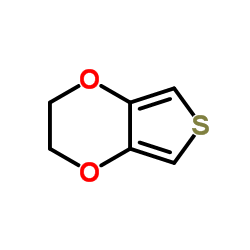3,4-Ethylenedioxythiophene

3,4-Ethylenedioxythiophene structure
|
Common Name | 3,4-Ethylenedioxythiophene | ||
|---|---|---|---|---|
| CAS Number | 126213-50-1 | Molecular Weight | 142.176 | |
| Density | 1.3±0.1 g/cm3 | Boiling Point | 210.5±19.0 °C at 760 mmHg | |
| Molecular Formula | C6H6O2S | Melting Point | 10 °C | |
| MSDS | Chinese USA | Flash Point | 81.1±21.5 °C | |
| Symbol |

GHS06 |
Signal Word | Danger | |
|
Evaluation of poly(3,4-ethylenedioxythiophene)/carbon nanotube neural electrode coatings for stimulation in the dorsal root ganglion.
J. Neural Eng. 12(1) , 016008, (2015) The dorsal root ganglion is an attractive target for implanting neural electrode arrays that restore sensory function or provide therapy via stimulation. However, penetrating microelectrodes designed for these applications are small and deliver low currents. ... |
|
|
Nitrite Oxidation with Copper-Cobalt Nanoparticles on Carbon Nanotubes Doped Conducting Polymer PEDOT Composite.
Chem. Asian J. 10 , 1892-7, (2015) Copper-cobalt bimetal nanoparticles (Cu-Co) have been electrochemically prepared on glassy carbon electrodes (GCEs), which were electrodeposited with conducting polymer nanocomposites of poly(3,4-ethylenedioxythiophene) (PEDOT) doped with carbon nanotubes (CN... |
|
|
Insertion of linear 8.4 μm diameter 16 channel carbon fiber electrode arrays for single unit recordings.
J. Neural Eng. 12 , 046009, (2015) Single carbon fiber electrodes (d = 8.4 μm) insulated with parylene-c and functionalized withpTS have been shown to record single unit activity but manual implantation of these devices with forceps can be difficult. Without an improvement in the insertion met... |
|
|
Redox-exchange induced heterogeneous RuO2-conductive polymer nanowires.
Phys. Chem. Chem. Phys. 16(24) , 12332-40, (2014) A redox exchange mechanism between potassium perruthenate (KRuO4) and the functional groups of selected polymers is used here to induce RuO2 into and onto conductive polymer nanowires by simply soaking the polymer nanowire arrays in KRuO4 solution. Conductive... |
|
|
Iron pyrite thin film counter electrodes for dye-sensitized solar cells: high efficiency for iodine and cobalt redox electrolyte cells.
ACS Nano 8(10) , 10597-605, (2014) Iron pyrite has been the material of interest in the solar community due to its optical properties and abundance. However, the progress is marred due to the lack of control on the surface and intrinsic chemistry of pyrite. In this report, we show iron pyrite ... |
|
|
Electrochemically Patterned Transducer with Anisotropic PEDOT through Liquid Crystalline Template Polymerization.
ACS Appl. Mater. Interfaces 7 , 18028-37, (2015) We have demonstrated patterning of highly ordered nanostructured conducting PEDOT (poly(3,4-ethylenedioxythiophene)) on glassy carbon electrode (GCE) through electrochemical polymerization of a biobased liquid crystalline template of EDOT-PDPPA (3-pentadecylp... |
|
|
Electrochemical evaluation of poly(3,4-ethylenedioxythiophene) films doped with bacteria based on viability analysis.
Bioelectrochemistry 105 , 50-5, (2015) To immobilize viable bacteria on an electrode, we present a novel and straightforward technique that relies on the negative ζ-potentials of bacteria for insertion into conducting polymers as dopants. In the present study, we conducted an electrochemical polym... |
|
|
Thiadiazolo[3,4-c]pyridine as an Acceptor toward Fast-Switching Green Donor-Acceptor-Type Electrochromic Polymer with Low Bandgap.
ACS Appl. Mater. Interfaces 7 , 11089-98, (2015) Thiadiazolo[3,4-c]pyridine (PT), an important analog of benzothiadiazole (BT), has most recently been explored as a novel electron acceptor. It exhibits more electron-accepting ability and other unique properties and potential advantages over BT, thus inspiri... |
|
|
Ion-selective electrodes in potentiometric titrations; a new method for processing and evaluating titration data.
Anal. Chim. Acta 888 , 36-43, (2015) A new method to convert the potential of an ion-selective electrode to concentration or activity in potentiometric titration is proposed. The advantage of this method is that the electrode standard potential and the slope of the calibration curve do not have ... |
|
|
Gold nanorod delivery of LSD1 siRNA induces human mesenchymal stem cell differentiation.
Mater. Sci. Eng. C. Mater. Biol. Appl. 54 , 142-9, (2015) Over the past decade, theranostic nanoparticles with microsize and multifunctional ability have emerged as a new platform in biomedical field, such as cancer therapy, optical imaging and gene therapy. Gene therapy has been recently shown as a promising tool f... |